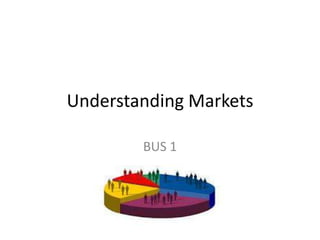
Understanding markets
- 1. Understanding Markets BUS 1
- 2. What is a market? A market is a place where buyers and sellers come together Traditionally markets were physical places, often in the centre of a community. Due to developments in communication, many markets exist through the postal service, telephone and internet links
- 3. Market classifications Geographical classification Local, national and international Physical and non-physical classification
- 4. Geographical classification Local markets • Most common form of market for consumer goods • Individuals buy products within a limited geographical area, close to where they live • Traditionally the local market was centred on the high street of a particular town or city, recently out-of-town shopping centres have developed • Although markets may be local the companies operating in them may be large multinational organisations
- 5. Geographical classification National markets • Can be classified in two ways; first a company would see itself operating in a national market if it sold its goods/services across all or most of the country. • Secondly, many industrial and primary products e.g. building materials are traded on a national or international scale. Businesses that provide these products usually supply them to other businesses .
- 6. Physical and non-physical markets Physical • There is an actual place where buyers and sellers meet, for example a marketplace, a shop or a businesses own premises • The product itself can be seen so the purchaser can make a well-reasoned decision
- 7. Physical and non-physical markets Non-physical (electronic) • Opportunities due to rapid advancements in technology • Telephone sales, internet (ecommerce), mobile phone apps • They are of particular significance to business start- ups as it gives them the opportunity to compete in a national market without high levels of capital
- 8. Demand Demand is the amount of a product or service that consumers are willing and able to buy at any given price over a period of time.
- 9. Factors influencing the demand for a product Price Income and wealth of consumers Tastes and fashion Prices of other goods Demographic factors Marketing and advertising Competitors’ actions Seasonal factors Government actions
- 10. Market segmentation The classification of customers or potential customers into groups (market segments), each of which responds differently to different products or marketing approaches
- 11. Market segmentation Segmentation analysis is where a firm uses quantitative and qualitative data or information to try to discover who buys its products and why
- 12. Remember! Market segmentation is based on CUSTOMERS rather than markets or products. It is a method of putting different customers into categories, to help a firm market its products
- 13. Market segmentation Geographic segmentation Demographic segmentation Psychographic segmentation Behavioural segmentation
- 14. Geographic segmentation • May include looking at the region of a country where consumers live and its nature i.e. rural or urban • Useful in large or culturally diverse markets where buying patterns are influenced by region • A drawback may be that regional and national boundaries become less important in determining tastes
- 15. Demographic segmentation Splits people up into different groups according to different characteristics: • Age • Gender • Social class • Income • Religion • Ethnic grouping
- 16. What type of segmentation? • Depends on the product/service being sold • In general, organisations identify the market segment(s) relevant to their products/ services • Products/services and the organisation’s approach to marketing is then geared to the targeted segments
- 17. Benefits of market segmentation To increase market share To assist new product development To extend products into new markets To identify ways of marketing a product
- 18. Drawbacks of market segmentation Difficulty in identifying the most important segments for a product Reaching the chosen segment with marketing Recognising changes in the segments interested in the product Meeting the needs of customers not included in the chosen segment.
- 19. Market mapping A technique that uses market segmentation to look at the features that distinguish different products or firms. Example: A car • Suitable for family use • Cheap to buy/run • Environmentally friendly • Fast • Safe and secure Features such as those listed can be ‘mapped’ in order to identify the extent to which an individual care possesses them
- 20. The trick with a market map is to ensure that market research confirms whether or not there is actually any demand for a possible “gap in the market”. There may be very good reasons why consumers do not want to buy a product that might, potentially, fill a gap.
- 21. Market size, growth and share Market size: the volume of sales of a product (e.g. the number of computers sold) or the value of sales of a products (e.g. the total revenue from computer sales). Market growth: the percentage change in sales (volume or value) over a period of time. Market share: the percentage or proportion of the total sales of a product or service achieved by a firm or specific brand product.
- 22. How is a market measured? Many markets are measured by VOLUME because it is easier for people to identify with an item than with a sum of money Example: It is easier to identify with 2.5 million cars being sold rather than £ 30 billion However in some markets such as hair care products there are many different products with huge variations in price, therefore it is easier to measure the market in terms of the value of the goods sold
- 23. Market growth • Market size can increase as a result of extra sales or persuading customers to pay higher prices • The market size indicates the potential sales for a firm • In growing markets there is more scope for increased sales, but competition is likely to become fiercer.
- 24. Factors influencing market growth • Economic growth • Nature of the product • Changes in taste • Social changes • Fashion
- 25. Market share